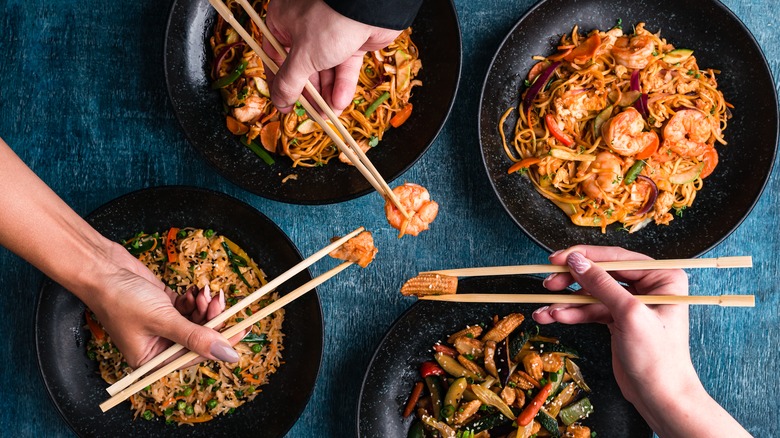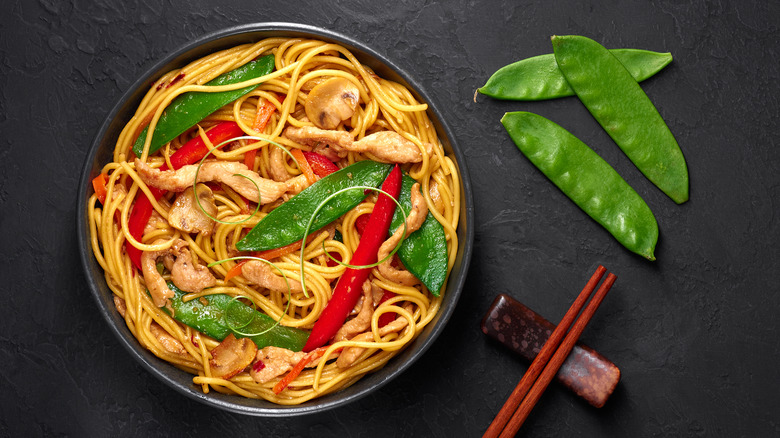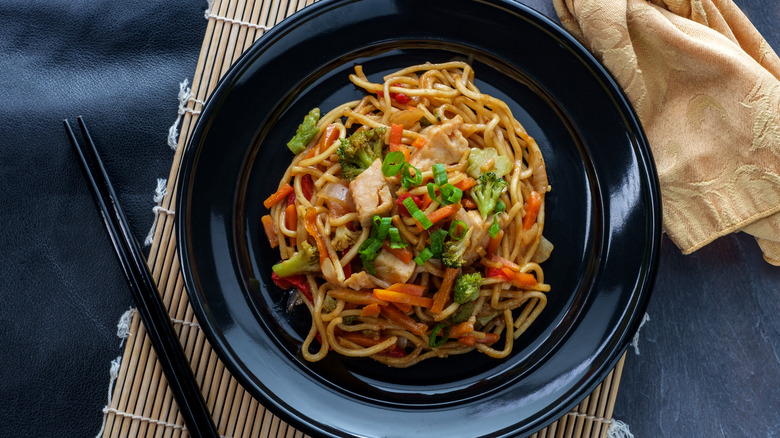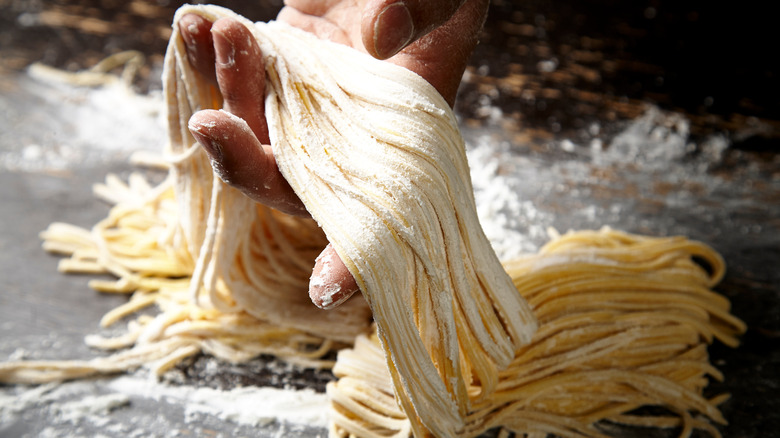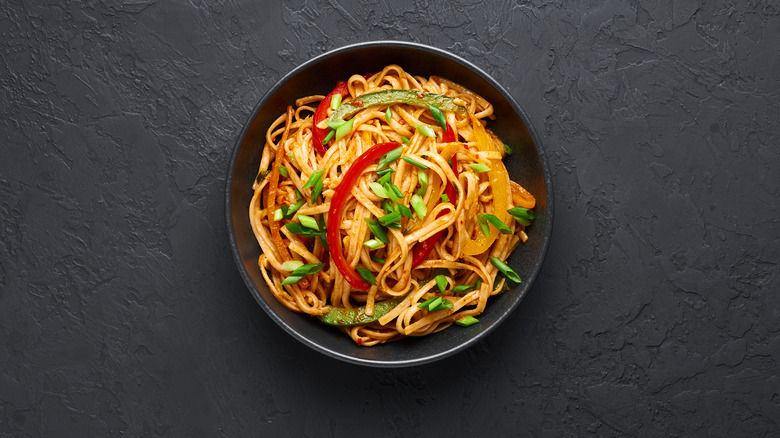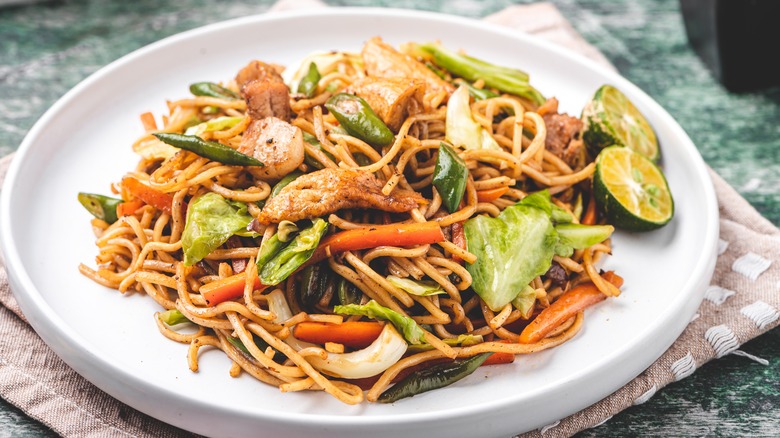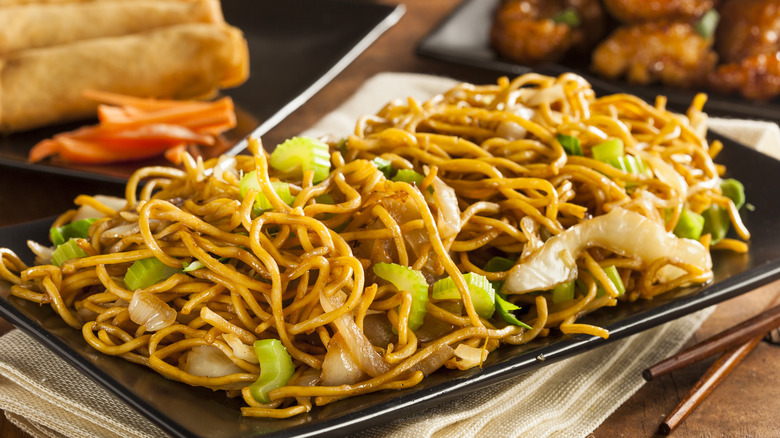Lo Mein Vs Chow Mein: What's The Difference?
Whether curled up on a couch with a box of takeout fried rice, or whipping up a rendition of General Tso's chicken, it's safe to say American-Chinese food delivers comfort. Rather than questioning its authenticity, let's consider the cuisine as its own delectable hybrid, born of immigration and diverse influences. Existing for nearly 150 years, this cuisine blends varied origins with time-honored techniques like stir-frying. Spun with accessibility for American diners, American-Chinese food demonstrates incredible innovation and resourcefulness.
Chow mein and lo mein have a unique standing in this culinary tradition — the dishes are widespread in both mainland China and abroad. Due to their versatility, the two recipes cover the same breadth as popular pasta dishes in Italy. Restaurants in China even specifically specialize in their preparation. Though the names and appearances of these two dishes may have a lot in common, there are dependable characteristics that distinguish lo mein and chow mein, so let's dive into the differences.
What is lo mein?
Many similarities exist between lo mein and chow mein — both dishes usually have an egg-noodle base, both are adaptable for myriad ingredients and flavorings, and both are frequently prepared in a wok. But the primary distinction of lo mein is that its noodles are never fried on their own. After the vegetables, proteins, and seasonings are initially fried, fully cooked egg noodles are added to the mix for the final part of lo mein preparation.
By avoiding the searing heat of being extensively fried, finished lo mein noodles remain soft and thick, allowing them to absorb sauces thoroughly. The relatively short frying time also prevents lo mein noodles from soaking up a considerable amount of cooking oil, resulting in a lighter taste that does not interfere with the natural flavors of accompanying veggies, meats, or spices. Because of this, lo mein is a saucy specialty that showcases the tastes of its individual ingredients amid a slippery but pleasantly chewy noodle texture, and it's often best served in a bowl.
What is chow mein?
Conversely to the cooking process of lo mein, par-boiled egg noodles are fried first when making chow mein, before vegetables, proteins, spices, and other additions are incorporated to be stir-fried together in the wok. This means that the noodles are partially browned and crisped in chow mein, as the extra frying time evaporates moisture and allows more oil to permeate the noodles.
With this cooking technique, chow mein has a pronounced fried-food flavor that extends beyond the noodles and into other ingredients that are mixed in with the dish. While subsequently poured sauces will moisten chow mein noodles somewhat, they retain a rigid shape and mouthfeel with bits of crispiness in spots where the noodles absorbed the most heat. As a result, chow mein is a relatively dry noodle specialty that works well as a starchy side dish, as it largely retains its shape when placed on a plate.
Lo mein is made with fresh noodles, while dried noodles are used for chow mein
Noodle making has long been an integral part of culinary culture in China, as archeological evidence indicates that noodles were eaten there at least 4,000 years ago. While both lo mein and chow mein are made with egg noodles, the two dishes differ when it comes to what form those noodles are in when they are cooked.
Lo mein is traditionally prepared with freshly made noodles, requiring only a short time of boiling to soften adequately before they're added to the wok after other ingredients have already been fried. The use of fresh noodles gives lo mein a pliable and chewy texture, while the strands remain absorbent for sauces.
Meanwhile, though fresh noodles can be used for chow mein, this dish is often made with dried noodles that must be submerged in hot water or par-boiled for up to six minutes before they're initially fried in a wok on their own. This gives chow mein noodles a stiff, almost crunchy consistency that is reinforced by their lengthier frying time in the wok. However, it's important not to try cooking too many noodles at once, or they won't be properly crispy; this is one of the mistakes everyone makes with chow mein.
Chow mein and lo mein are made with different wok techniques
The principal difference between these two noodle dishes is evinced through their names. Chow mein refers to stir-fried noodles, while lo mein means tossed noodles. Both are usually made in a wok, although this cooking tool is more important for chow mein, as its components are typically fried over high heat with a fair amount of oil, generating the smoky flavor known as wok hei while giving the noodles a browned appearance. The longer noodle-cooking time and considerable amount of oil used for chow mein results in the flavors of the ingredients intermingling thoroughly.
Since lo mein noodles are fresh and fully cooked before they're added late in the frying process, not as much heat is required for this dish compared to chow mein. Less oil is also needed for lo mein, so the fried-food taste is more subtle and the flavors of the vegetables, proteins, and seasonings stand out unadulterated by the cooking process. The lower heat required for lo mein makes it easier to replicate the wok technique in a thick skillet, since the vessel is used more to mix everything together under heat than to actively stir-fry the ingredients.
Lo mein is served with more sauce than chow mein
Fresh lo mein noodles are excellent for soaking up sauce, so at the end of the cooking process, the entire mixture is usually bathed in a larger amount of seasoned flavoring. Though some cooks prefer to let the noodles and sauce heat up for an extra minute or so in the last stage of preparing lo mein, what's most important is to continually stir the almost-ready dish so that the noodles don't get overdone and squishy.
On the other hand, with chow mein more oil is added to the wok than with lo mein, generating crispy noodles stir-fried with other ingredients to develop its own taste less reliant on sauces. Chow mein noodles will absorb sauces with enough time, but the additional oil cooked into these noodles may impact a sauce's taste, so many diners prefer using only a drizzle of sauce or none at all on their chow mein.
Several sauce ingredients are shared for both chow mein and lo mein recipes, including soy sauce, oyster sauce, and sesame oil. However, lo mein sauce is often prepared thicker to better coat the noodles, and it comprises a large part of this specialty's overall flavor.
Recipes for chow mein and lo mein have similar ingredients but different techniques
The beauty of chow mein and lo mein is the flexibility for choosing ingredients, whether making it at home or ordering it. Both frequently feature a large portion of vegetables, ranging from simple onions, celery, and broccoli to intriguing combinations of snow peas, mung bean sprouts, and bell peppers. The choice of meats is also wide open — including chicken, pork, and shrimp — while either dish can be made vegan- or vegetarian-friendly by replacing meat with mushrooms, tofu, or other plant-based proteins. The main difference between the two dishes is in the cooking techniques, not the ingredients.
Home cooks interested in making lo mein will find our garlic chicken lo mein recipe to be a quick and easy introduction to creating the specialty in less than a half hour. From there move up to our roasted pork lo mein recipe, which requires more time to cook a pork tenderloin in the oven before adding it to the other ingredients in the wok, but it's worth the wait. However, our vegetarian lo mein recipe takes well under 20 minutes, and features the tantalizing taste of caramelized coconut sugar.
As for making chow mein at home, it takes only 15 minutes to prepare our easy shrimp chow mein recipe, and everyone can enjoy our vegan chow mein recipe. What to do if you end up with leftovers? Don't forget that chow mein sandwiches were once a lunchbox staple.
